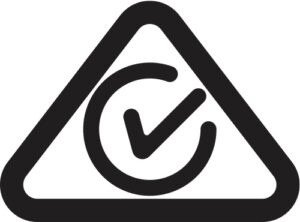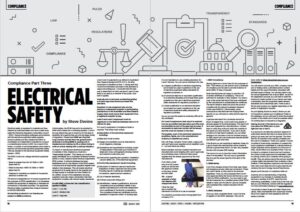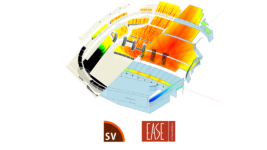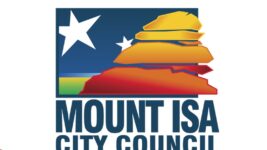News
16 Oct 2018
Compliance Part Three – Electrical Safety
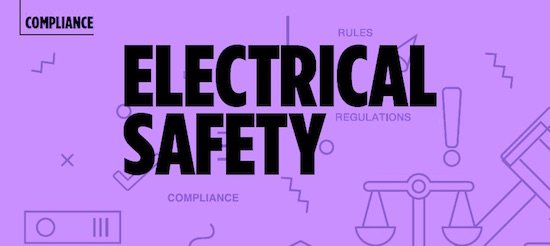
Subscribe to CX E-News
Compliance Part Three
Electrical Safety
by Steve Devine.
Electrical safety is regulated in Australia and New Zealand by individual states who have a peak body called the Electrical Regulatory Authorities Council – ERAC.
Several emerging challenges and problems with the electrical equipment safety systems across Australia and New Zealand led ERAC to commission an independent consultant to conduct a comprehensive review in 2007. As a result of the review, a number of recommendations were made to improve and harmonise electrical equipment safety. This has resulted in the Electrical Equipment Safety System – EESS
The EESS covers low voltage electrical equipment that is:
– Rated at greater than 50v AC RMS or 120V ripple-free DC
– Rated at less than 1000V AC RMS or 1500V ripple-free DC
– Designed or marketed as suitable for household, personal or similar use.
The above is designated as “In-scope” equipment for the purposes of EESS classification. It is immaterial whether the equipment is designed or marketed for commercial or industrial purposes. The applicable Electrical Safety Australian/New Zealand standard is AS/NZS 3820:2009.
All electrical products in our industry are subject to EESS provisions.
Unfortunately, the EESS has yet to be adopted by NSW which makes for a confusing situation. It won’t be long before they get on board so for the sake of simplicity let’s assume they are one big happy family of regulators.
Those from NSW can ring their local member and tell them the government’s tardiness in joining EESS is causing lots of headaches and making my life a misery trying to write an article dealing with a national situation.
To import or manufacture electrical equipment in Australia or New Zealand you must be a “Responsible Supplier”. This means you must be easily identifiable via an Australian Business Number (ABN) or a New Zealand Inland Revenue Department (IRD) number. A national database has been established and is a key feature of the EESS system. It requires that all responsible suppliers register their details in this database.
This will enable electrical equipment to be easily traced to the supplier and its legal supply in Australia and New Zealand to be verified.
As part of the registration process, suppliers must also make a declaration that their equipment complies with relevant safety standards.
As with EMC, a three-tier risk classification applies to EESS.
Level 1 – Low risk
Level 2 – Medium risk
Level 3 – High risk.
Level 2 and 3 equipment is as defined in Australian/New Zealand standard AN/ZS 4417.2. All other equipment is classified as level 1.
Having said that, I found the information provided in this standard is vague and ambiguous. I concluded that the best way to determine if an item was level 3 was if it was likely to be used by a member of the public, then level 3 applies.
Anybody who is seriously considering getting a product approved should purchase this standard.
Suppliers of new equipment who are the second or subsequent supplier in participating jurisdictions in the Australian and New Zealand supply chain must source their equipment from a registered supplier by law.
Level 2 and Level 3 equipment must be registered on the National Database before it is offered for sale.
For Level 2 equipment a Compliance folder is required. This folder must contain:
a) Description of the electrical equipment including:
(i) Make and model number;
(ii) Design documentation such as descriptions, circuit diagrams, drawings;
(iii) I llustrations and specifications including copies of rating labels or final mark-ups of artwork of labels and colour photographs showing internal and external construction; and
(iv) Instructions regarding the operation, installation, use and safety, etc, of the electrical equipment.
b) Conformity assessment results including:
(i) Description of methods used and results and evaluations of tests, inspection and any audits including reports covering any deviations, concessions, departures and variations
(ii) List of relevant standards;
(iii) Critical component listing; and
(iv) Identification, relevant qualifications, technical competence and accreditation details of any parties undertaking the conformity assessment. And a certificate of Conformity is mandatory. The compliance folder and certificate must be available for inspection within 10 working days.
It is not mandatory to use a testing laboratory for Level 2 devices. You can use an individual who has:
a) A degree qualification in electrical engineering and at least two years’ experience in the use
of electrical equipment safety standards for regulatory purposes; or
b) An advanced diploma or equivalent qualification in an electrical discipline and at least three years’ experience in the use of electrical equipment safety standards for regulatory purposes; or
c) A trade qualification in an electrical discipline and at least four years’ experience in the use of electrical equipment safety standards for regulatory purposes.
As you can see this system is extremely difficult for the uninitiated.
For Level 3 equipment a test report is required from an accredited test laboratory and this must be submitted as part of the approval process. If successful an approval number will be issued, and this must be marked on the item.
Fortunately, most of the electrical equipment, amplifiers, lights, etc in the entertainment industry is classified as Level 2.
240-volt Plugs, Sockets, Power Cable, Laptop and wall wart type power supplies are all classified Level 3.
I am sure there are others.
Most Australian and New Zealand importers and manufacturers avoid tangling with Level 3 approvals by purchasing power cords and inline power supplies that are already approved by the local manufacturer.
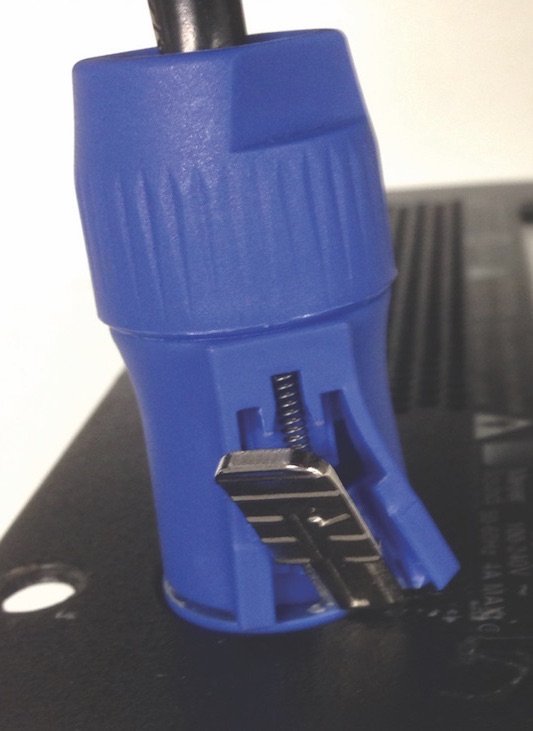 If you take a close look at an IEC power cable you should see the approval number on the plug, socket and the cable.
If you take a close look at an IEC power cable you should see the approval number on the plug, socket and the cable.
Pic – A good example of what can happen with unapproved items
I think the best way to explain the mechanics of all this is to use an example.
You decide to purchase some moving lights from company XYZ.
1. EMC Compliancy
Moving lights are a Level 2 item for the purposes of EMC. That means you will need to have a certificate of compliancy and be able to provide evidence of same within 10 days of request.
Most manufacturers are happy to provide a CE or similar certificate of compliancy. This is not sufficient for Australia or New Zealand. You need a copy of the actual test report that was undertaken by the manufacturer to substantiate the certificate.
The report needs to state and prove the product complies with the relevant Australian standard.
In this case EN55015. Unfortunately, some unscrupulous manufacturers are forging these reports, so you will need to verify that the report is genuine.
A genuine test report for a luminaire should be about 45 pages long. Look to see if any graphs or pictures appear to be photoshopped. The report will have been prepared by a test laboratory. Contact them to verify they exist and verify the contents of the report you have received. If you are in doubt or there is no test report available, you can either arrange to do one here or look for another product. An EMC report will cost somewhere between $3000 and $5000 to get done here.
If the fixture you are importing is relatively cheap it’s a good chance the manufacturer will be unable to provide a genuine test report. It’s also very possible the item will not pass EMC testing. The onus is on you to have the correct information when it is requested. The only way to guarantee this is to get the actual reports at the start of the process.
2. EESS Safety
A lot of the cheaper product from Asia uses cheap and dangerous power cable and connectors. These are Level 3 items, so they need to be removed regardless. Once you have swapped them out for local approved items the fixture will then be a Level 2 item for EESS certification. You now need to get the item inspected by a qualified person (refer EESS detail) to make sure it’s safe for use and complies with Australian/New Zealand standard AN/ZS 4417.2.
3. ERAC Database
Once you have completed items 1 and 2 its time to register on the ERAC database.
This can be done online at https://equipment.erac.gov.au/Registration
You will need to provide your ABN, company name and or trading name, authorised person contact details and the usual information requested with all these types of things. You will also need to pay the annual registration fee of about $200.
As part of the registration process you will need to enter the brand and model number of your device and make a declaration that the equipment meets relevant standards and is electrically safe. There is also a fee for each product you register depending on the period of registration required.
As your lighting fixture is a level 2 device you are not required to upload your Compliance Folder to the database, but you will need to enter the physical location of the folder and it must be available within 10 working days on request by a Regulator.
Having done all of the above you can now place the RCM mark on your light and use or sell it.
It is obvious to me after the extensive research to write these articles that this is an issue that is not going to go away and can’t be ignored. The down side for an importer is the wearing of liability and the cost of compliance. There is an upside.
In some countries it is becoming mandatory to present the local compliance credentials to customs before an import shipment will be allowed out of the port of entry. South Africa is an example of this. If you try to import a container of stock and can’t produce the correct locally approved documentation, there is a strong chance your container will be going to landfill. They are serious about this and are requiring a higher safety test standard than Australia or New Zealand.
If this regulatory approach was introduced here, that could mean the end of grey imports and certainly the end of dodgy knockoff electronics.
Maybe worth the pain of compliance after all.
Anybody who is manufacturing or importing equipment in our industry in Australia should become a member of ACETA. Apart from the networking possibilities, a peak body is the only way that you can effectively connect with the regulators. For more information please go to www.aceta.org.au
I would like to thank Susan and Peter Twartz from Jands, Frank Andrewartha from Quest and Andrew Wood from Digilin for their assistance with this series of articles.
This article first appeared in the October 2018 edition of CX Magazine – in print and online. CX Magazine is Australia and New Zealand’s only publication dedicated to entertainment technology news and issues. Read all editions for free or search our archive www.cxnetwork.com.au
© CX Media
Read the Set:
Part One – Compliance for Australian Entertainment Products (Aug 2018)
Part Two – EMC: Electromagnetic Compatibility (Sept 2018)
Part Three – Electrical Safety (Oct 2018)
UPDATE – ACETA Solves the Compliance Issue (CX Dec-Jan 2018)
Subscribe
Published monthly since 1991, our famous AV industry magazine is free for download or pay for print. Subscribers also receive CX News, our free weekly email with the latest industry news and jobs.

